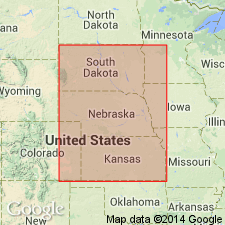
- Usage in publication:
-
- Devil's Gulch beds
- Modifications:
-
- Biostratigraphic dating
- AAPG geologic province:
-
- Chadron arch
Summary:
Pg. 170. The 3 phases of Pliocene, in northern and northwestern Nebraska are (ascending) Valentine beds, Snake Creek beds, Devil's Gulch beds. [Barbour and Cook, 1917a, 1917b, are only known usages of Devil's Gulch beds.]
[Misprint (US geologic names lexicon, USGS Bull. 896, p. 2227): "Notes on the skull of Metoreodon" should be Nebraska Geol. Survey, vol. 7, not vol. 8.]
Source: US geologic names lexicon (USGS Bull. 896, p. 604, Valentine entry p. 2227).
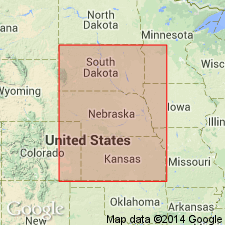
- Usage in publication:
-
- Devil's Gulch beds
- Modifications:
-
- Biostratigraphic dating
- AAPG geologic province:
-
- Chadron arch
Summary:
Pg. 173. The Valentine beds are probably a lower phase than either the Snake Creek or the Devil's Gulch. [Barbour and Cook, 1917a, 1917b, are only known usages of Devil's Gulch beds.]
Source: US geologic names lexicon (USGS Bull. 896, p. 604, Valentine entry p. 2227).
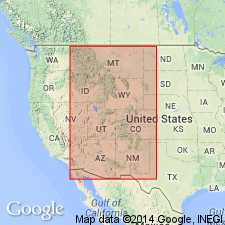
- Usage in publication:
-
- Devil's Gulch beds
- Modifications:
-
- Areal extent
- AAPG geologic province:
-
- Chadron arch
Summary:
Pg. 18, 35. Devil's Gulch beds. Although this term has been less used, it precedes Valentine and was adequately defined, stratigraphically, from the first, in terms of what was then known; if redefined, it is available to replace Valentine formation, if the latter be considered preoccupied or unduly ambiguous. [Age is Miocene and Pliocene.]
[Notable exposures in Brown Co., northwestern NE.]
Source: US geologic names lexicon (USGS Bull. 1200, p. 1104).
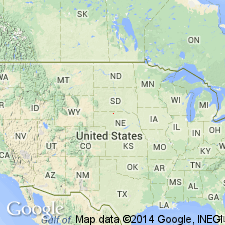
- Usage in publication:
-
- Devil's Gulch Member
- Modifications:
-
- Principal reference
- Revised
- AAPG geologic province:
-
- Salina basin
Summary:
Pg. 401 (fig. 9), 406, fig. 16 (map). Devil's Gulch Member of Valentine Formation. Recognized in Nebraska and South Dakota. Consists of yellowish, fine-grained, clay-filled, massive sand. Thickness 30 to 60 feet. Underlies with sharp contact the Burge Member of Valentine Formation or, where absent, the Cap Rock Member of Ash Hollow Formation. Gradationally overlies Crookston Bridge Member of Valentine Formation. Sand of the Devil's Gulch Member is much finer than that of the Burge and Crookston Bridge Members. Fossils (notably "Devil's Gulch Horse Quarry" from south side of Devil's Gulch canyon). Age is early Pliocene.
Type locality: in Devil's Gulch of Dutch Creek, in SE/4 sec. 28, T. 32 N., R. 21 W., Brown Co., northwestern NE.
Source: Publication.
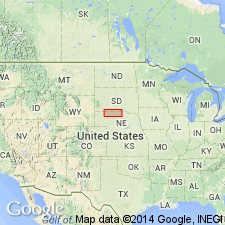
- Usage in publication:
-
- Devil's Gulch Member
- Modifications:
-
- Areal extent
- AAPG geologic province:
-
- Chadron arch
- Salina basin
Summary:
Pg. 230 (fig. 3), 246 (fig. 4), 280-284. Devil's Gulch Member of Valentine Formation of Ogallala Group. A widespread, massive, yellow-gray argillaceous sandstone, about 50 to 60 feet thick. Unconformably underlies Burge Member and overlies Crookston Bridge Member, both of the Valentine Formation. Equivalent to "Upper Valentine beds" of Johnson (Amer. Jour. Sci., 5th ser., v. 31, p. 469, 1936). Fossils. Includes vertebrate Devil's Gulch Horse Quarry local fauna. Age is middle Miocene; late Valentinian NALMA (late Barstovian NALMA of some paleontologists). [On p. 252, authors state Valentinian is applied to faunas that occur in the Valentine Formation and the Valentinian represents a period of possibly 3 m.y. duration. Some paleontologists place the Valentine Formation in the middle Barstovian to early Clarendonian NALMA.]
Source: Publication.
For more information, please contact Nancy Stamm, Geologic Names Committee Secretary.
Asterisk (*) indicates published by U.S. Geological Survey authors.
"No current usage" (†) implies that a name has been abandoned or has fallen into disuse. Former usage and, if known, replacement name given in parentheses ( ).
Slash (/) indicates name conflicts with nomenclatural guidelines (CSN, 1933; ACSN, 1961, 1970; NACSN, 1983, 2005, 2021). May be explained within brackets ([ ]).

